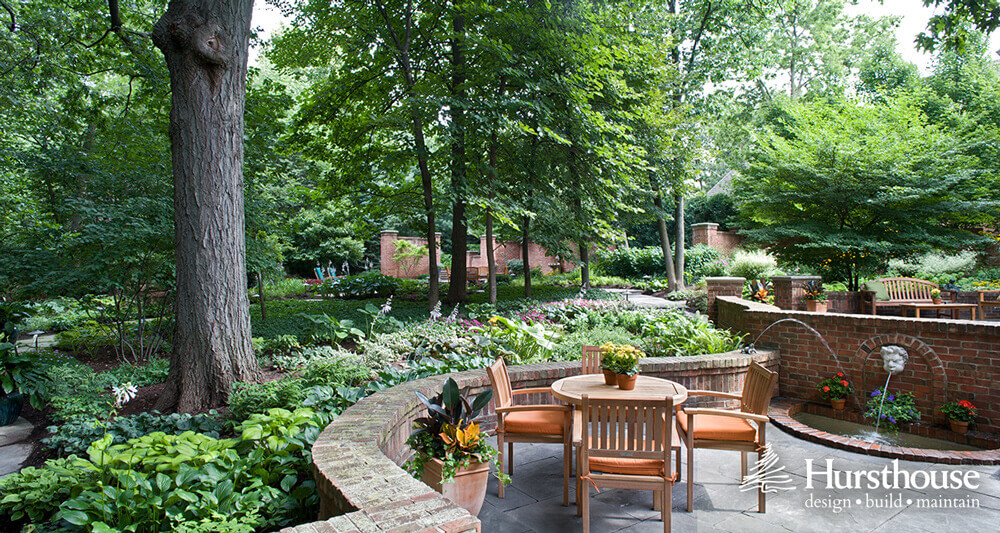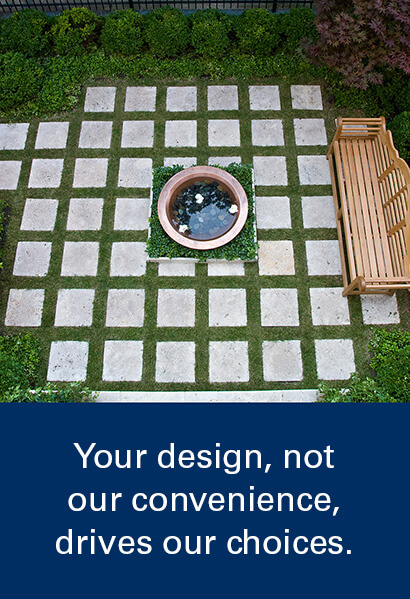Rule 1: Continuity is Key.
Your new landscape should tie into your house seamlessly – after all, they’re both part of the same home.
But tying into your house does not mean matching it exactly. “Too little continuity is called ‘chaos,’” Bob Hursthouse says, “but too much is called ‘monotony’.” To walk a line between these extremes, our design teams create a “materials palette” as part of their process. They look at both horizontal and vertical surfaces in your landscape, then either connect them exactly to your house or suggest a material that’s different but complimentary. The result is an outdoor living space that still feels like your living space – not a completely different home.
When you see your conceptual design, look for the ways it echoes your existing home.
Rule 2: Define the spaces.
While there may not be a lot of walls like in your home, your landscape should still have separate spaces within it. There might be a quiet breakfast area over here for just the two of you – while over there, there’s space to have company over for a big event.
When you see your conceptual design, look at the ways the space is divided up. Did your designer listen to you? Will the spaces you see accommodate the types of uses and the numbers of people you expect to use them for?
Rule 3: Design for all four seasons.
A common temptation is to plan your yard for summer use – and forget about the rest of the year. But your home is a great place to live year-round. So should your landscape be too.
“You experience a landscape 12 months of the year,” Bob Hursthouse says. “Maybe you’re not outside that whole time – but you’re looking at it. So we like to consider the view from indoors as well as from the patio. We look at how the light might change from June to December and decide if you’ll need more shade in the summer or more light in Winter. And we look at plants that provide you with different points of interest throughout the seasons.”
When you see your conceptual design, ask your landscape designer how it will function in different seasons of the year.
Rule 4: Design for the senses.
We experience the world through our senses – and a great way to experience your design ahead of time is to imagine what you’ll see and hear (or even smell, taste and touch!) when you’re there.
Great designers know how to attract the human eye – they work with color, plan at the proper scale, and build movement into your landscape design to make it beautiful. We design for your other senses too – by considering how a pool patio should feel on bare feet, or by using flowing water or fluttering leaves to drown out the sound of a neighbor’s loud summer barbeque.
When you see your conceptual design, ask your landscape designer what features will draw the eye – and the ear, nose and fingers – when you’re actually living there. It’s one of the best ways to take your design off of the page – and into your life.
Rule 5: Design for decades, not just years.
Another designer temptation is to over plant a yard. It looks nice when it’s new – but then deteriorates over time. To really get it right, consider how your landscape might look when the plantings have matured.
“I always hate to tear apart a 5-year-old patio because it wasn’t built right,” Bob Hursthouse says. “If you do it correctly, you do it once – and it lasts for your lifetime.”
When you see your conceptual design, ask your landscape designer how it will change over 5, 10, or 20 years. If you’re planning to stay for a while, that might matter to you.


